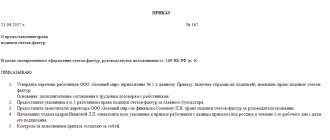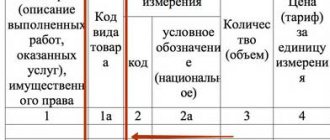Invoice for services (shipper and consignee)
In accordance with the Rules, if the seller and the shipper are the same person, then in line 3 “The shipper and his address” is written “the same person” (letter of the Ministry of Finance of Russia dated October 15, 2008 No. 03-07-09/32).
Note! This rule does not apply to filling out lines regarding information about the buyer, who is also the consignee.
In this case, when selling goods, line 4 of the invoice indicates the full or abbreviated name of the consignee in accordance with the constituent documents and his postal address, and line 6 indicates the full or abbreviated name of the buyer in accordance with the constituent documents.
https://youtu.be/WHMdeTGPmc4
How to correctly fill out the “Consignee” column when issuing a UTD?
The purchasing organization itself and its legal address, or the actual address of the warehouse owned by it, must be indicated in the UTD as the consignee
03/12/2019Russian Tax Portal
The answer was prepared by:
Expert of the Legal Consulting Service GARANT
Gilmutdinov Damir
The answer has passed quality control
The supplier () sends the goods by rail. Delivery conditions - free carriage to the buyer's station. Next, the goods are transported by the buyer’s vehicles to another city to their warehouse. The buyer () does not have its own access railway tracks. Therefore, the consignee indicates in the railway consignment note, which actually accepts the wagons onto its railway tracks and then unloads the goods onto the buyer’s vehicles for a fee.
Who should be indicated in the “Consignee” column when issuing a UTD? What address of the consignee should be indicated in the UPD? Will there be problems with VAT refund if different consignees or different consignors are indicated in the UTD and in the railway waybill?
Having considered the issue, we came to the following conclusion:
The purchasing organization itself and its legal address, or the actual address of the warehouse belonging to it, must be indicated in the UPD as the consignee.
In the above circumstances, the postal address of the consignee in the UPD, to a greater extent, has the character of an identifying detail, and not one that determines the place of delivery of the goods.
We see no obstacles to deducting VAT if the consignees (shippers) in the UTD and railway invoices are different.
Indication in the UPD as the address of the consignee of the railway station at which the goods arrive and (or) the address of the legal entity - the owner of the access roads, in our opinion, is incorrect and can only be indicated as additional information.
Rationale for the conclusion:
As is known, the universal transfer document (hereinafter referred to as UTD) combines the form of an invoice and a primary accounting document (in particular, a bill of lading) (letter of the Federal Tax Service of Russia dated October 21, 2013 N ММВ-20-3/ [email protected] , hereinafter — Letter from the Federal Tax Service of Russia dated October 21, 2013). In this regard, in relation to the situation under consideration, one should be guided, on the one hand, by the requirements of Chapter 21 of the Tax Code of the Russian Federation, the Rules for filling out an invoice used in VAT calculations (approved by Decree of the Government of the Russian Federation of December 26, 2011 N 1137, hereinafter referred to as Rules N 1137) , and on the other hand, the norms of Chapter 25 of the Tax Code of the Russian Federation and the Federal Law of December 6, 2011 N 402-FZ “On Accounting” (hereinafter referred to as Law N 402-FZ).
The amounts of VAT presented by the supplier on purchased goods (works, services) are accepted for deduction on the basis of a properly executed invoice and after the goods (works, services) are accepted for accounting in the presence of the relevant primary documents (clause 1 of Article 169, clause 1 Article 172 of the Tax Code of the Russian Federation).
Following part 2 of Art. 9 of Law N 402-FZ, the indication of the proper consignee and consignor is not included in the mandatory details of the primary accounting document. In this part, the primary accounting document must indicate the persons (or person) who made the transaction, operation and those responsible for its execution (etc.), and, accordingly, their (his) signatures.
The railway consignment note (hereinafter referred to as the railway bill) is a transportation document, i.e. a document confirming the conclusion of a contract for the carriage of goods (Article 2 of the Charter of Railway Transport of the Russian Federation (Federal Law dated January 10, 2003 N 18-FZ, hereinafter referred to as the Railway Transport Charter). In general, the Rules for filling out transportation documents for the transportation of goods by rail were approved by order of the Ministry of Railways of the Russian Federation dated 06.18.2003 N 39 (hereinafter referred to as the Rules of the Ministry of Railways).
The railway invoice or transport bill of lading serve as primary documents on the basis of which transportation costs are accepted for accounting and taken into account for profit tax purposes (letters of the Ministry of Finance of Russia dated November 2, 2015 N 03-03-06/1/63124, dated March 19, 2010 N 03- 03-06/1/153).
Thus (in relation to the situation under consideration), goods are accepted for accounting on the basis of the UTD, but not the railway waybill. It also (UPD) serves as the basis for deducting VAT amounts presented by the supplier (Letter of the Federal Tax Service of Russia dated October 21, 2013).
In addition, as the Russian Ministry of Finance once indicated in letter dated August 10, 2005 N 03-04-11/202, regarding the concepts of consignor and consignee provided for by the Railway Railway Charter, these concepts are used for the purpose of applying specifically the Railway Railway Charter.
According to paragraphs. “g” clause 1 of Rules No. 1137 in line 4 “Consignee and his address” of the invoice, the full or abbreviated name of the consignee in accordance with the constituent documents and his postal address are indicated. As you can see, it is not specified here which address - legally or actual delivery address should be indicated on the invoice. What distinguishes this invoice detail from the buyer’s address indicated in line 6a, where it is necessary to indicate “the address specified in the Unified State Register of Legal Entities, within the location of the legal entity, …”.
In letters of the Ministry of Finance of Russia dated 09/15/2014 N 03-07-Р3/46026, dated 05/25/2012 N 03-07-14/54, dated 06/13/2012 N 03-07-09/61, Federal Tax Service of Russia dated 01/21/2010 N 3-1-11/22 explains that invoices in terms of filling out the relevant lines are drawn up (“filling in ... is possible”) on the basis of the first primary accounting document (“based on a similar indicator of the invoice”). The data of the primary documents drawn up when carrying out a business transaction, including on the persons who carried out operations for sending, transporting and receiving cargo, must correspond to the actual circumstances (see also Resolution of the Presidium of the Supreme Arbitration Court of the Russian Federation dated October 18, 2005 N 4047/05).
Please note that from earlier letters of the Ministry of Finance of Russia, for example dated November 13, 2008 N 03-07-09/38, dated August 26, 2008 N 03-07-09/24, it followed that the constituent documents must correspond to both the name and postal address, in particular of the shipper.
Note that the parties can supplement the UPD form with any other indicators (details) necessary to reflect special terms of transactions (letters of the Federal Tax Service of Russia dated December 23, 2015 N ED-4-15/22619, dated January 24, 2014 N ED-4-15/ [email protected] . Thus, the UPD can reflect both the legal address of the purchasing organization and the actual address of the warehouse, and equally, as an addition, the destination station where the goods are delivered at the expense of the supplier can be indicated.
In the situation under consideration, the goods (cargo) are accepted at the destination station by employees of the organization (buyer) and unloaded into its vehicles. Following the rule about indicating actual circumstances as the consignee in the primary accounting document (and therefore in the invoice), the organization (buyer) itself must be indicated as the consignee in the UTD, but not the owner of the access roads (railway infrastructure).
With all of the above, in the circumstances under consideration, the supplier’s obligations to deliver the goods are limited only to delivery to the destination station. Therefore, in our opinion, indicating the address of the consignee is only a requisite identifying the organization (consignee, buyer). In this regard, both the legal address of the organization and the actual address of the warehouse belonging to it can be indicated as a postal address.
In our opinion, indicating only the address of the destination station as the postal address of the consignee cannot be considered correct.
In conclusion, let us recall that, on the one hand, “the name and address of the shipper and consignee” are defined as mandatory invoice details (clause 3, clause 5, article 169 of the Tax Code of the Russian Federation). At the same time, as indicated in paragraph 2 of clause 2 of Art. 169 of the Tax Code of the Russian Federation, are not grounds for refusing to accept for deduction of VAT errors in invoices and adjustment invoices, which do not prevent the tax authorities from identifying during a tax audit:
— seller, buyer of goods (works, services), property rights;
— name of goods (works, services), property rights;
- their cost;
— as well as the tax rate and VAT amount charged to the buyer.
The Ministry of Finance of Russia also draws attention to this norm, for example, in the letter of Russia dated September 15, 2014 N 03-07-Р3/46026, commenting on the procedure for filling out the lines “Consignor” and “Consignee” in invoices. And since the universal transfer document, as we noted above, combines the form of an invoice and the corresponding primary documents, the above rule of paragraph 2, clause 2, art. 169 of the Tax Code of the Russian Federation is equally applicable to UPD.
For your information:
According to the general rules, in accordance with clause 2.8 of the IPS Rules, in the “Consignor” column, the full name of the shipper and his OKPO code for a resident of the Russian Federation are indicated, in brackets - the four-digit code assigned by the carrier. In the column “Postal address of the shipper” the full postal address (with index) of the shipper with the name of the region, republic, region, district, city, village, street, house number, office (or apartment) number, contact telephone number is indicated (clause 2.9 of the Rules MPS). The columns “Consignee” and “Recipient's postal address” are filled in in the same order (clause 2.10 of the IPS Rules).
In this case, when filling out the columns “Consignor” and “Consignee”, the name of only one legal or individual person is indicated (clause 2.11 of the IPS Rules).
As a rule, the name of the owner of the railway infrastructure or the owner of a non-public railway track is indicated in the “Consignee” column of the Railways (for example) when transporting its own empty car to a railway laying station (clause 10.3 of the Rules of the Ministry of Railways).
In Art. 2 of the Railway Railway Charter, the consignee (recipient) is defined as an individual or legal entity authorized to receive cargo, luggage, freight luggage, or an empty freight car. Moreover, if we look at examples from arbitration practice, when delivering to the destination station (on a non-public railway track), the actual consignee must be indicated as the consignee, but not the owner of the infrastructure (see, for example, the resolution of the Federal Antimonopoly Service of the West Siberian District dated May 26. 2009 N F04-3060/2008(7273-A45-21)).
In the resolution of the Federal Antimonopoly Service of the North-Western District dated January 28, 2010 N F07-11722/2008, the court took the side of the taxpayer in a situation where in the invoices issued by suppliers, the line “Consignor and his address” contained the corresponding name and address of the seller, and not the consignor indicated in the consignee's acceptance certificates and railway waybills.
Post:
Comments
What information does the column contain?
The invoice form itself and the rules regarding the procedure for filling it out were approved by Resolution No. 1137, issued by the Government of the Russian Federation in 2011. Section I of this regulatory act is devoted specifically to the invoice. He indicates that the document must contain a number of information, starting from the date of preparation and number, ending with the identifier of the government contract (if the invoice is used in the field of government procurement).
Specifically about the sender and recipient of the cargo, the document indicates the following information:
- Name indicating the form (JSC, LLC, etc.) for organizations, name - for individual entrepreneurs.
- Legal address of the organization.
- TIN and checkpoint. If the organization is a tax agent (for example, it is a separate division of the checkpoint) (clause 2 of Article 161 of the Tax Code of the Russian Federation), then a dash is placed in the column instead of the data.
IMPORTANT: In 2020, the procedure for indicating the address has undergone changes!
Previously, this column was filled out in accordance with the Charter for a legal entity. Now it is filled out according to the Unified State Register of Legal Entities (or according to the Unified State Register of Entrepreneurs for individual entrepreneurs). This means that now the address must be indicated in detail: if the Charter allows only the indication of a locality, then complete data is entered into the Register - right down to the office number.
Different seller and shipper for invoice
№ 1137.
Polukhina Marina | Head of the Methodology and Consulting Department of CJSC Delovoy Profile, full member of the Chamber of Tax Consultants of Russia and the IPB of the Moscow region, d. Situation: is it possible to deduct VAT on an invoice received by fax? The seller and the shipper are different legal entities. The trading organization does not have its own warehouse: solution options and tax consequences. Typically, invoices are numbered in ascending order for the entire organization within one year or one tax period. Enterprises must strictly comply with them, otherwise they will face problems with tax deduction or refund (clause 2 of Article 169 of the Tax Code of the Russian Federation). Another situation may arise: the document is filled out correctly, but it contains unnecessary information.
The list of types of state control in which a risk-based approach is applied has been expanded. Now this list also includes checks for compliance with labor legislation requirements carried out by the labor inspectorate.
When is it necessary to write details?
The specifics of filling out an invoice depend on the specific agreements under which it is used. The fact is that we can talk about the consignor and the consignee only in the case when the actual transfer of goods (cargo) takes place under the contract. If we are talking only about the provision of services, the corresponding terms are simply not used.
In this case, the columns relating to the seller and buyer are always filled in in the invoice. This is due to the requirements established by Art. 169 of the Tax Code of the Russian Federation, and the terminology used in the Code. According to it, any person who provides services or transfers goods is considered a seller, regardless of who he is from the point of view of the Civil Code - actually a seller, a performer, etc. The same applies to the buyer.
Accounting and legal services
Info
The number must correspond to the current numbering, which the company can develop independently for its convenience. Usually the numbering is continuous in order from the beginning of the year, quarter or month, depending on the number of documents drawn up.
The digital number may be supplemented by letters or symbols. Date – the day the document is issued, must fall within the period allotted for the transfer of the contract for services (5 days from the date of signing the act or 5 days from the end of the month or quarter of service provision, if the act is not signed). 1a Date – the actual day of their entry. But when shipping goods, filling out these lines is mandatory. However, difficulties always arise with which address to enter: legal or actual. The opinions of regulatory authorities on this issue differed. Thus, the financial department believes that the legal address should be indicated in lines 3 and 4 of the invoice (letters from the Ministry of Finance of Russia dated November 13, 2008 No. 03-07-09/38 and dated August 26, 2008 No. 03-07-09/24). In turn, the tax authorities are of the opinion that these lines should include the actual addresses of the shipper and consignee (for example, the address of a rented office or warehouse from where the cargo is shipped).
This conclusion is contained in the letter of the Federal Tax Service of Russia dated January 21, 2010 No. 3-1-11/.
What address should I put on the invoice?
A tax refund will be refused if it is impossible to accurately identify the services declared by the contractor. Services must not only be named, there must be an indication of a document defining the procedure for providing, performing or delivering these services. The detail must be sufficient to correctly determine the type of services and their nature.
Examples of wording for service names:
- repair work according to act No. 12 dated 09/01/2016;
- accounting support services under agreement No. 1 dated 02/01/2016;
- services for marketing research of the building materials market for April – June 2020.
If representatives of one party to the transaction are different organizations
Situations are possible when one person acts as a supplier, but the cargo is actually sent from the warehouse of another. This occurs, in particular, during transit deliveries, when the goods are sent to the recipient without registration at the warehouse of the intermediary seller. In this case, in fact, there are not two, but three parties involved in the transaction :
- supplier (seller);
- sender of the cargo;
- buyer-consignee.
In the event that the shipper and the seller do not coincide with each other, this fact must be reflected in the invoice indicating the name, address and details of each of them. Lack of data may result in the tax deduction not being provided.
IMPORTANT : Transactions are also possible where the buyer and consignee do not match. In this case, complete data must also be provided for each of them.
Now you know what to do in situations where the seller and the shipper are different legal entities. The same applies to cases where the buyer and consignee are different organizations.
In the materials of our specialists you can find out many interesting details about the invoice. Read about what codes are in an invoice, how to indicate transaction codes and various quantities in a document, why and in what cases an order is needed to sign invoices, how to fill out the “country code” column, and also what a customs declaration or number is customs declaration.
How to fill out the lines correctly?
If it concerns the shipper. According to the rules established by the current edition of Resolution No. 1137, the lines relating to the shipper are filled in as follows:
- The full name is indicated, but an abbreviation is also allowed.
- The address is indicated according to the Unified State Register of Legal Entities.
- If he and the seller are one person, then, according to paragraphs. “e” clause 1 of section I of the resolution, in the corresponding line you can write “he”. If the sender of the goods is not the seller, but another person, the mail address of the shipper is indicated. Finally, if the invoice is issued under an agreement relating not to goods, but to services or work, nothing is written on the line - a dash is placed.
- If the document is issued by an agent acting on his own behalf, but purchasing goods from two or more sellers, in the line “Consignor” all of them are indicated, but separated by a semicolon.
Now about situations when we fill out lines about the consignee. Resolution No. 1137 for the consignee establishes similar standards:
- The name is indicated - full or abbreviated.
- The address according to the Register is indicated.
- If the invoice is for services, a dash is placed in the column concerning the recipient of the cargo. The wording “aka” is not provided for by the resolution.
- If there are two or more consignees, the names and addresses of each are indicated separated by a semicolon.
Accounting and legal services
But the absence of a full address according to the Unified State Register of Legal Entities is a significant error, which may become a reason for refusal to deduct. If representatives of one party to the transaction are different organizations. Situations are possible when one person acts as a supplier, but in reality the cargo is sent from the warehouse of another. This occurs, in particular, during transit deliveries, when the goods are sent to the recipient without registration at the warehouse of the intermediary seller.
In this case, in fact, there are not two, but three parties involved in the transaction:
- supplier (seller);
- sender of the cargo;
- buyer-consignee.
In the event that the shipper and the seller do not coincide with each other, this fact must be reflected in the invoice indicating the name, address and details of each of them. Lack of data may result in the tax deduction not being provided.
- Legal address of the organization.
- TIN and checkpoint. If the organization is a tax agent (for example, it is a separate division of the checkpoint) (clause 2 of Article 161 of the Tax Code of the Russian Federation), then a dash is placed in the column instead of the data.
- IMPORTANT: In 2020, the procedure for indicating the address has undergone changes! Previously, this column was filled out in accordance with the Charter for a legal entity. Now it is filled out according to the Unified State Register of Legal Entities (or according to the Unified State Register of Entrepreneurs for individual entrepreneurs).
This means that now the address must be indicated in detail: if the Charter allows only the indication of a locality, then complete data is entered into the Register - right down to the office number. When is it necessary to write details? The specifics of filling out an invoice depend on the specific agreements under which it is used. The fact is that we can talk about the shipper and the consignee only in the case when the actual transfer of goods (cargo) takes place under the contract.
Common Mistakes
One of the typical mistakes when filling out invoices is the situation when, when issuing a document relating to the delivery of goods and provision, both the “Consignee” and “Consignee” are forgotten to fill out. In this case, the Federal Tax Service Inspectorate, having examined the document, may declare that all details are not indicated - and, accordingly, there will be no tax deduction.
Another, smaller error is the incorrectly specified name of one of the parties. The rules require that names be written in the same way as in the statutory documents. However, if the error is minor and allows the party to be identified, a deduction will be granted.
Finally, it is an equally minor mistake to leave a blank line instead of a dash if the other details are filled out correctly. But the absence of a full address according to the Unified State Register of Legal Entities is a significant error, which may become a reason for refusal to deduct.
Name of goods, works, services
In column 1, indicate the name of the product or a description of the work performed, services provided, and property rights. This procedure is provided for both invoices that are issued upon shipment or upon receipt of an advance payment.
This is stated in subparagraph “a” of paragraph 2 of Appendix 1 to the Decree of the Government of the Russian Federation of December 26, 2011 No. 1137.
Situation: can the name of the trademark be written in a foreign language on the invoice? This name is also indicated in the certificate of conformity for the product.
Yes, you can. The main thing is to indicate the name of the product in Russian.
This follows from paragraph 9 of the Accounting and Reporting Regulations and is confirmed in the letter of the Federal Tax Service of Russia dated December 10, 2004 No. 03-1-08/2472/16 and Article 6 of the Convention for the Protection of Industrial Property of March 20, 1883.
For example, it would be correct to fill out column 1 of the invoice as follows: “Satellite phone PETR 1990.” In this case, all requirements regarding the correct completion of invoices will be met.
Situation: is it possible to fill out one invoice for both goods and services at the same time?
Yes, you can. In this case, write down services, works and goods in the invoice as independent items.
Indeed, for different groups: goods, works and services, quantitative and cost indicators will differ (letter of the Ministry of Finance of Russia dated May 24, 2006 No. 03-04-10/07).
In addition, be sure to complete line 3, “Consignor and his address,” and line 4, “Consignee and his address.” For services and works, they are marked with dashes. But, when at least one product is recorded in the invoice, they must be filled out - you cannot put dashes in these lines (subparagraph 3, paragraph 5, article 169 of the Tax Code of the Russian Federation, subparagraph “e”, paragraph 1 of Appendix 1 to the Decree of the Government of the Russian Federation dated December 26, 2011 No. 1137).
Situation: is it necessary to decipher the composition of construction and installation work performed under a construction contract in column 1 “Name of goods (description of work performed, services provided), property rights" of the invoice?
If a short title of the work allows inspectors to correctly identify it, then a detailed description is not required. Next to the short name, it is enough to indicate the details of the contract or other document from which the scope of work can be determined.
A description of the work performed is a mandatory detail of the invoice (subclause 5, clause 5, article 169 of the Tax Code of the Russian Federation). However, this provision does not provide for the obligation to provide a complete transcript of the work performed. In addition, if the invoice contains any inaccuracies that do not prevent the identification of the name of the work, the tax inspectorates have no right to refuse a deduction on such an invoice. This position is confirmed by the letter of the Ministry of Finance of Russia dated May 10, 2011 No. 03-07-09/10.
So that the tax inspectorate can obtain information about what kind of work was performed, in column 1 next to the short name, indicate the details of the relevant contract. In addition, inspectors can obtain a detailed breakdown of the work performed from the estimate, the report in form No. KS-2 and a certificate of the cost of work performed in form No. KS-3. The validity of this approach is confirmed by arbitration practice (resolutions of the FAS Moscow District dated July 19, 2012 No. A41-34328/11, dated February 6, 2012 No. A40-46403/11-91-198, Volga District dated December 1, 2011 No. A65-4112/2011, West Siberian District dated October 17, 2011 No. A45-25079/2009).
If in column 1 you indicate only a short name without reference to the relevant agreement, the inspectors will most likely refuse the deduction. Indeed, in this case they will not be able to determine what work was performed.
Consignee details on the invoice for services
When delivering a completed service subject to VAT to the customer, the contractor is obliged to prepare an invoice in the form established by Resolution 1137. This Resolution was prepared by the Government of the Russian Federation and contains standard invoice forms (initial and adjustment), as well as registers intended for their accounting.
Why do the contractor and the customer need an invoice? Both parties need an invoice, so the contractor prepares it in two copies with the same content. The contractor enters the prepared document into the Sales Book using a registration entry, during which the details and indicators are transferred from the sales register to the columns of the Book.
In the future, this information will be useful when filling out a VAT return and calculating the final amount of added tax for transfer for the quarter. The consignor can be not only the seller (owner, proprietor) of the cargo, but also another person (a person who has a warehouse and acts as a consignor on behalf of the owner cargo, or a person performing actions on his own behalf, but at the expense and on behalf of the owner of the goods).
If the seller of goods under the contract is one person, and these goods are shipped from the warehouse of another person, then line 3 “Consignor and his address” indicates the full or abbreviated name of the organization from whose warehouse the goods were shipped, and his postal address (letter Ministry of Finance of Russia from 13.11.
When performing work (providing services), there are no “consignee” as such, so the corresponding lines in the invoice are either not filled in at all, or dashes are placed in them. Today, this rule is fixed directly in Appendix No. 1 to the Rules for maintaining purchase books and sales books .The unit of measurement and its OKEI code for services must be filled in while the following conditions are met:
- The price in the contract is stated per unit of measurement, and not the total price for the entire service;
- This unit of measurement is included in the corresponding classifier (first or second sections).
In other situations, dashes are placed in the columns. 3 Quantity, volume – if there are dashes in columns 2 and 2a, then they are placed in this field. Otherwise, the number of services is indicated in accordance with the specified unit of measurement. 4 Price per unit – is entered if this price is specified in the contract and gr.
In what ways and in what form to issue an invoice?
An invoice must be issued every time you sell goods, work, services or property rights. This can be done in one of two ways - on paper or electronically.
The first method is the generally accepted standard. The paper form of the invoice and the rules for filling it out are approved in Appendix 1 to the Decree of the Government of the Russian Federation of December 26, 2011 No. 1137. In this case, the invoice can be filled out:
- using a computer;
- by hand;
- combined (partly using a computer, partly by hand).
If necessary, additional details can be entered into this form (letter of the Federal Tax Service of Russia dated July 18, 2012 No. ED-4-3/11915). To do this, add new lines (columns) to the invoice. The Russian Ministry of Finance recommends placing them after the signatures of the manager and chief accountant (letter dated November 24, 2020 No. 03-07-09/68169).
The second method, electronic, is used less so far. To transmit an invoice to the buyer electronically, you need to obtain his consent. In addition, your and your counterparty’s means of receiving, exchanging and processing invoices electronically must be compatible. They must comply with established formats and procedures. This is stated in paragraph 2 of paragraph 1 of Article 169 of the Tax Code of the Russian Federation.
Invoices are issued and received electronically in the manner approved by Order of the Ministry of Finance of Russia dated November 10, 2015 No. 174n. Electronic formats of invoices were approved by orders of the Federal Tax Service of Russia dated March 24, 2020 No. ММВ-7-15/155 and dated March 4, 2020 No. ММВ-7-6/93. Until July 1, 2020, both formats operate in parallel. That is, during the period from May 7, 2020 to June 30, 2020, you can issue (compile) invoices in any of these formats. From July 1, 2020, it is prohibited to use the old electronic format in relations with counterparties. This procedure is established by paragraphs 2 and 3 of the order of the Federal Tax Service of Russia dated March 24, 2020 No. ММВ-7-15/155.
Situation: is it possible to issue one invoice for several contract agreements addressed to one customer?
Yes, you can. But provided that the certificates of completion of work under all contracts are signed on the same day or on different days, but within five days.
Current legislation does not prohibit issuing one invoice for several acts of work performed and even for different contracts (letter of the Ministry of Finance of Russia dated November 10, 2020 No. 03-07-09/64493). However, the invoice must be issued within five calendar days after the completion of the work (rendering of services). This is the requirement of paragraph 3 of Article 168 of the Tax Code of the Russian Federation. Therefore, the invoice can only include the cost of those works that were completed no earlier than five calendar days before the invoice is issued. That is, certificates of work performed (services rendered) under all contracts must be signed either on the same day or on different days, but within five days.
For example, acts of acceptance of completed work are signed:
- under agreement No. 1 - July 6;
- according to agreement No. 2 - July 10.
On July 10, the contractor issued one invoice for the cost of work performed under both contracts. The deadline established for issuing an invoice under agreement No. 1 had not expired by July 10.
Another situation. Acceptance certificates for completed work were signed by:
- under agreement No. 1 - July 6;
- according to agreement No. 2 - July 14.
In this case, it is impossible to include the cost of work performed under different contracts in one invoice. By July 14, the period allotted for issuing an invoice under contract No. 1 had expired.
In what cases are the lines Consignor and Consignee filled in in invoices?
For the shipment of goods, provision of services and mixed, t In what cases are the lines “Consignor” and “Consignee” filled in invoices? For shipment of goods, provision of services and mixed. those. goods and services in one invoice. And how does this violation affect the deduction of VAT? Fill in lines 3 “Consignor and his address” and 4 “Consignee and his address” only when selling goods. When drawing up an invoice for work performed (services rendered), lines 3 and 4 must be filled with a dash.
When issuing one invoice for goods shipped and work performed (services rendered), it is necessary to fill out line 3 “Consignor and his address” and line 4 “Consignee and his address.”
Invoice number and date it was issued
Please indicate the number and date of the invoice on line 1.
You can number invoices in the order that is convenient for you. Write it down in your accounting policy. This is usually a simple numbering in ascending order from the beginning of each calendar year. But another procedure may be provided. The main thing is that the numbering is increasing and continuous.
The law does not provide for the ability to resume the numbering of invoices from the first serial number. However, from the letter of the Ministry of Finance of Russia dated October 11, 2013 No. 03-07-09/42466, we can conclude that deviation from the established procedure is not an error due to which the buyer may be deprived of the right to a tax deduction. The main thing is not to violate the chronology (subparagraph “a”, paragraph 1 of Appendix 1 to the Decree of the Government of the Russian Federation of December 26, 2011 No. 1137).
Advice: if an organization has violated the numbering of invoices, then such an error does not need to be corrected. This violation is not grounds for refusal to deduct VAT.
The main thing is that the rest of the invoice is drawn up correctly. And so that the invoice with the “wrong” number is indicated in section 9 of the VAT return with the same number.
An error in the invoice number does not prevent you from determining:
- seller and buyer or performer and customer;
- name and cost of goods sold, work performed, services provided, property rights transferred;
- tax rate and VAT amount charged to the buyer.
And if so, then tax inspectors do not have the right to refuse the buyer to deduct VAT on such an invoice.
This follows from paragraph 2 of paragraph 2 of Article 169 of the Tax Code of the Russian Federation.
An invoice is issued within five calendar days from the date of shipment of goods, provision of services, performance of work or transfer of property rights. Using this rule, write the date on line 1.
This follows from the provisions of subparagraph “a” of paragraph 1 of Appendix 1 to Decree of the Government of the Russian Federation of December 26, 2011 No. 1137 and paragraph 3 of Article 168 of the Tax Code of the Russian Federation.
Situation: how to number invoices if products are shipped both from the head office and from separate divisions of the organization?
Number invoices in ascending order. To the invoice numbers of a separate division, add the index of this division.
To do this, add a separating line “/” to the invoice serial number and enter the digital index of the separate division. The digital index is approved in the order on accounting policies. This will allow you to determine which division of the organization issued the invoice. This procedure follows from paragraph 1 of Appendix 1 to Decree of the Government of the Russian Federation of December 26, 2011 No. 1137 and letter of the Ministry of Finance of Russia dated October 11, 2013 No. 03-07-09/42466.
It is not necessary to maintain separate books of purchases and sales for separate divisions. It is enough to register the invoices in the appropriate books of the parent organization. The same applies to intermediary organizations, which must maintain invoice logs. Invoices issued (received) by separate divisions as part of intermediary activities can be recorded by the organization in its accounting journal. This conclusion follows from the letter of the Ministry of Finance of Russia dated March 24, 2015 No. 03-07-11/16050.
In the “Payer” column of the TTN, you must indicate the organization paying for the carrier’s services
According to the contract, we (the supplier) must deliver the goods to the buyer’s warehouse. For this we hire a transport company. When filling out the TTN, a question arose: who should be indicated in the header part of the TTN in the “Payer” column: us (we pay for the services of the transport organization) or our buyer (he pays for the goods transported under this invoice)?
You will not find the answer to your question in the Instructions for filling out the TTN (Approved by Resolution of the State Statistics Committee of Russia dated November 28, 1997 N 78). But in 1983, the Instruction on the procedure for payment for the transportation of goods by road was approved (Approved by the Ministry of Finance of the USSR N 156, the State Bank of the USSR N 30, the Central Statistical Office of the USSR N 354/7, the Ministry of Automobile Transport of the RSFSR N 10/998 dated November 30, 1983 (hereinafter referred to as the Instruction) ), which is currently not invalid. It says that in the line “Customer (payer)” of the TTN, you must indicate the name of the organization making payment for transport work under this TTN (Clause 9 of Appendix No. 3 to the Instructions). Although this document establishes the rules for filling out a no longer valid form, the terms used in it are quite applicable to the current TTN. The indication in the “Payer” column of the customer under the transportation contract can also be justified as follows. The purpose of the TTN is to record payments for transportation, and not for the transported goods. In practice, many organizations indicate in the “Payer” column the person who pays for the goods, comparing the product section of the TTN with the TORG-12 invoice.
TTN for transit delivery
We do not have our own warehouse. The goods are shipped from the warehouse of our supplier, who delivers the goods directly to our buyer. The supplier (aka the shipper) writes out the TTN and fills out all the columns, including the product section with its sales prices. Upon receipt of the cargo, our buyer signs the TTN and receives a copy of it. We don't want our buyer to know our supplier and his prices. Is there a possibility to solve this problem?
Under such conditions, you will not be able to influence the filling of the TTN. The columns “Price” and “Amount” must be filled in by the supplier. It is unlikely that you will be able to persuade him to leave these columns empty, since in the event of unforeseen circumstances he will not be able to recover damages from the transport company. And he is also unlikely to agree to indicate your sales prices in the TTN.
Shipper when picking up goods
Instructions for accounting in 1C programs Instructions for development on 1C Consultations on legislation Books and periodicals Reference information. As the consignee, the UPD must indicate the purchasing organization itself and its legal address, where it should indicate “the address specified in the Unified State Register of Legal Entities, within the location. Invoices are issued to a separate division. In accordance with Appendix No. 1 to. Neither the Tax Code nor the Motor Transport Charter states who should be considered the consignor for self-pickup. Explanations from regulatory authorities are contradictory. In private explanations, representatives of the Federal Tax Service explained that the consignor in this case must be the seller, and in one of their letters they say that the consignor in this case can also be the buyer. In our opinion, when transferring goods at the supplier’s warehouse to the UTD, it is more correct for the shipper to write the seller.
When, who and why do you need TTN?
When checking the validity of VAT deductions, tax officials pay special attention to the presence and correctness of execution of such a primary document as a consignment note (form N 1-T). This is a unified form, but there are no clear instructions about in what cases it needs to be filled out, how to fill it out correctly, who needs it, etc. Therefore, trying to avoid disputes with inspectors, most organizations issue a TTN with or without reason. Let's first figure out when TTN is still needed. Form N 1-T is intended for recording the movement of inventory items and payments for their transportation by road (Instructions for the use and completion of forms of primary accounting documentation for recording work in road transport, approved by Resolution of the State Statistics Committee of Russia dated November 28, 1997 N 78). Tax officials believe that when delivering goods by road, a TTN should be issued in all cases without exception (Clause 2 of the USSR Ministry of Finance Instruction No. 156, the USSR State Bank No. 30, the USSR Central Statistical Office No. 354/7, the RSFSR Ministry of Autotransport No. 10/998 dated November 30, 1983 “On the procedure settlements for the transportation of goods by road"; clause 49 of the Guidelines for accounting of inventories). And some courts support them (Resolutions of the FAS VSO dated April 30, 2009 N A19-10710/08-11-F02-1646/09, dated November 11, 2008 N A19-4274/08-43-F02-5524/08). But both the Civil Code and the Charter of Motor Transport clearly state that the TTN confirms the conclusion of a contract for the carriage of goods (Article 8 of the Federal Law of November 8, 2007 N 259-FZ “Charter of Motor Transport and Urban Ground Electric Transport” (hereinafter referred to as the Charter); Clause 2 of Article 785 of the Civil Code of the Russian Federation). That is, the TTN serves as a supporting document to confirm the services provided for the movement of cargo. It only needs to be drawn up when a transport company is hired to transport the goods.








